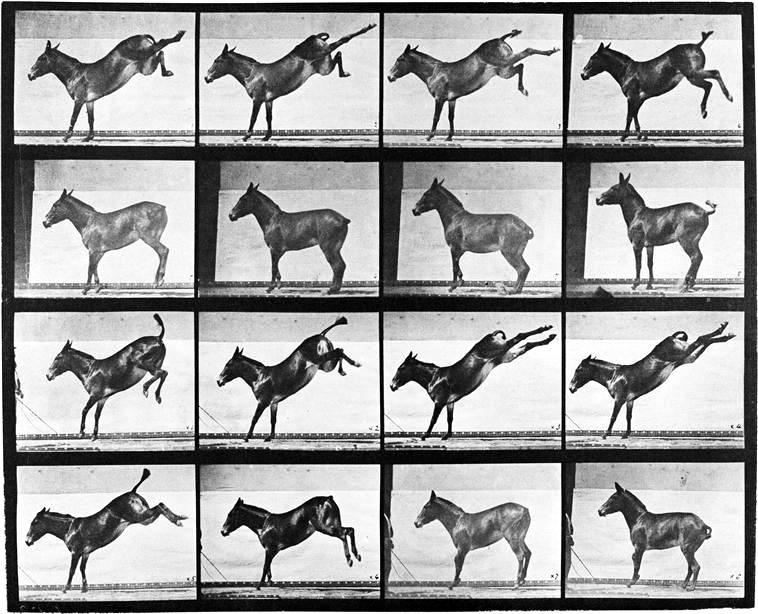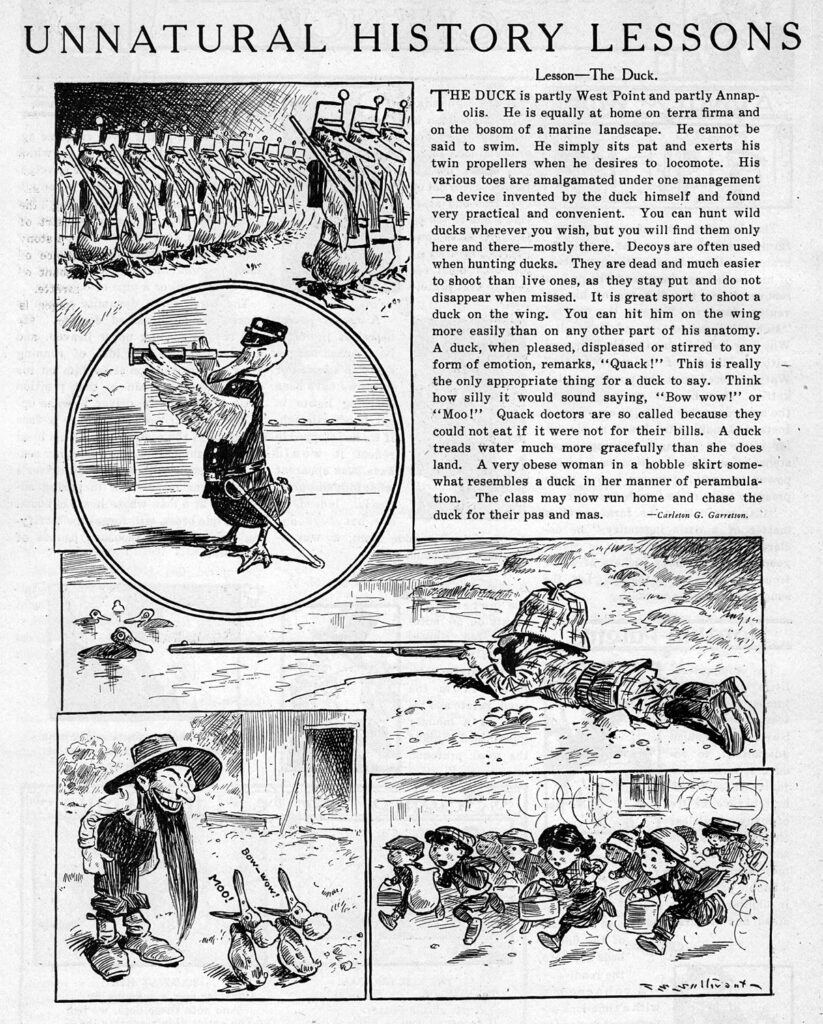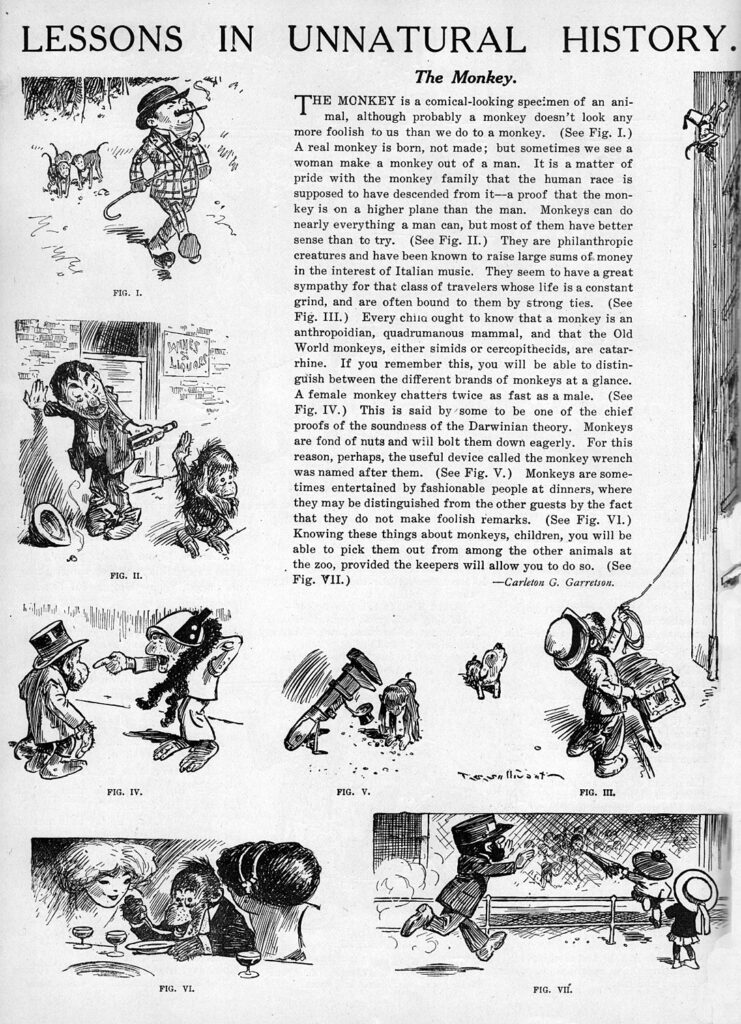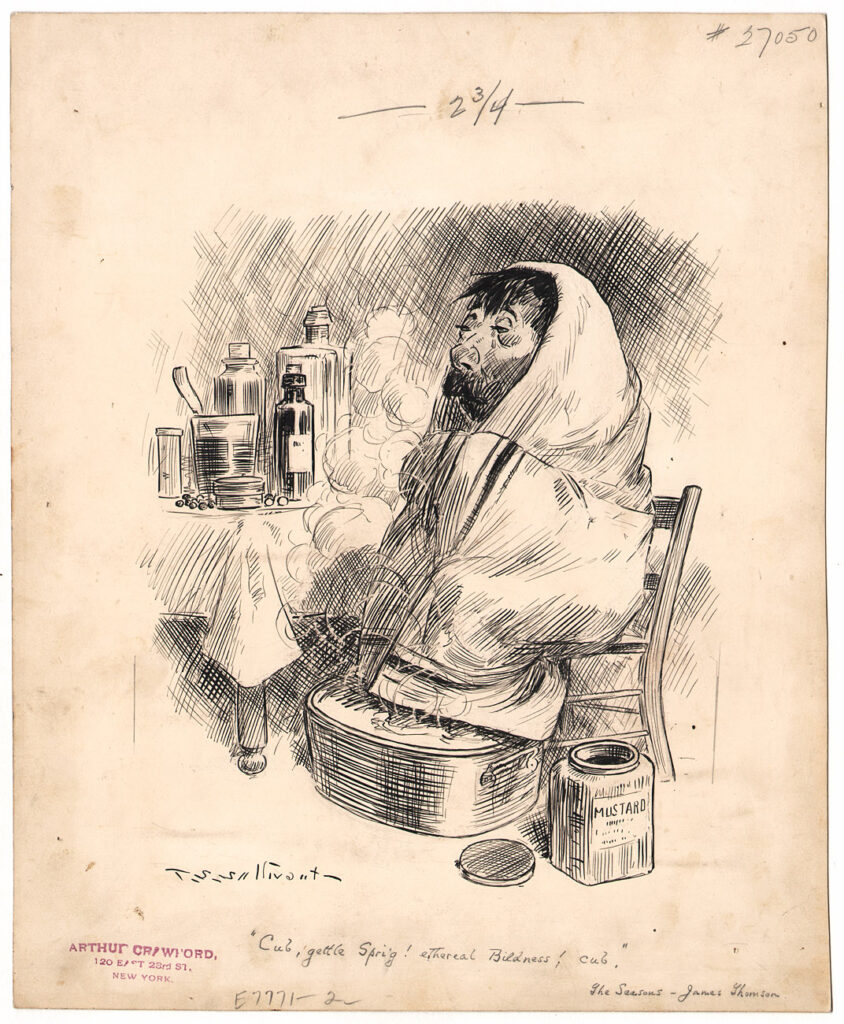The Action-Packed Stop-Motion of T.S. Sullivant
Much has been written about T.S. Sullivant’s wonderful work over the years, so I’ll try not to rehash what’s been written previously, but for those new to Sullivant’s work, 1) I envy your first-time exposure to his incredible drawings, and 2) I’ll present the briefest of biographical blurbs.
Thomas Starling Sullivant (1854–1926) was born in Columbus, Ohio and raised partially in Germany. When Sullivant was 18, he moved from Columbus to Europe for a few years, eventually moving back to the States, where he studied with the famous painter and teacher Thomas Eakins, at the Pennsylvania Academy of the Fine Arts in Philadelphia. At 32, Sullivant was a late entrant to the cartooning game, with his first cartoons appearing in 1886 in Truth, a humor magazine. Not long after that, Sullivant’s work began appearing in Puck, Life and Harper’s Weekly. Sullivant remained in Philadelphia, studying with the painter Edward Moran and apprenticing with E.B. Bensell, an illustrator known for his ink drawings and wood engravings. At the turn of the 20th century, Sullivant began contributing to Life magazine instead of Puck, and in 1904 he signed a contract with William Randolph Hearst to produce editorial cartoons, an association which lasted until 1907. Sullivant returned to the pages of Life magazine in 1911, continuing his long association with the publication until his passing in 1926.
What is it about T.S. Sullivant’s artwork that resonates with so many people? Technically, Sullivant was superb, a master of pen and ink. His contour line work combined with his hatching and cross-hatching technique was full of life, creating forms and space with strong depth, weight, and movement. Technical proficiency in a medium is one thing, but there has been a boatload of proficient artists whose work is spot-on but lacks life. As corny as it may sound, Sullivant brought a joie de vivre to his work that has been matched by few others in the past hundred years.

Early on, in the 1880s and 1890s, Sullivant’s ink work was academically strong, but lacked the liveliness of his later artwork. Given his training, that academic inclination makes perfect sense. But as Sullivant’s work matured, his line became more expressive, especially in the hatching and cross-hatching that helped make up the weight of his forms. I don’t know for sure, but I imagine Sullivant was aware of the changes in pen and ink cartoon work in Great Britain in the late 1880s and 1890s, especially the way in which cartoonist Phil May was handling shapes in his cartoons. It’s possible that May’s more open approach to drawing may have rubbed off onto Sullivant, though May’s work was much more shape-based, as opposed to the beautifully organic forms of the figures that Sullivant constructed.
Fans of Sullivant’s drawings tend to focus on his figures, and rightfully so. His character designs are borne out of an incredible knowledge of human and animal anatomy. But it is his ability to caricature people and animals alike, and make it look so damn easy, that seems to strike admirers most. Ralph Bakshi talked about running across a box of Sullivant clippings while at Terrytoons and being bowled over by the inventiveness he found in his introduction to Sullivant’s work.

When you look at a Sullivant figure, you see a form in motion, but just so, almost as if it is in stop-motion, with the potential energy to keep moving. Often when I see his work, I’m struck by the similarities in Eadweard Muybridge’s photographic work on animal locomotion. I know that A.B. Frost was fully aware of Muybridge’s work and I’m sure that many cartoonists and artists of the period were equally aware of it.

Sullivant had that gift of portraying a figure in movement, from a stampeding animal to a human with his or her back arched, capturing it at the apex of the movement. The weird thing is that Sullivant was by no means an artist who created dynamic compositions in his work, but the drawings almost always showed movement through the figures, the ink work and the atmosphere. Unlike his contemporary Will Crawford, who loved to fill up every available space in a drawing with detail, Sullivant used the open space to allow the movement to be one of the stars of the drawing.
On last thing before moving onto the images. Fans of Sullivant’s work are aware of the change in his approach to drawing from the 1880s through the 1920s. Over the course of that last 20 or so years, Sullivant used a razor as a drawing tool more and more, scratching through the paper to help create contrasting lines and movement. Frederick Burr Opper, the creator of Happy Hooligan, once commented on Sullivant’s frequent razor blade use saying, “If Tom Sullivant scratched his head as much as his paper, he’d draw better cartoons!” I, for one, am glad he scratched both his head and the paper, as the physicality of the originals can be both seen and felt through those marks.
Most of the T.S. Sullivant images that I’ve saved come from online sources and have been seen by thousands of people already. But I do have scans of some of Sullivant’s Unnatural History Lessons from Judge magazine which I don’t find online, so I’ll start with those. These were features written by Carleton Garretson, and beautifully adorned by Sullivant. I’ll sneak in a few other pieces, because 1) I can’t help myself, and 2) there’s no such thing as too much T.S. Sullivant. And have no fear. This will not be the last of T.S. Sullivant’s work on this blog.
I hope you enjoy the work. Thanks for tuning in.

Judge magazine, circa 1910

Judge magazine, circa 1910

Judge magazine, circa 1910

Judge magazine, circa 1910

I’m a sucker for Sullivant’s Noah cartoons. I love the body language he employs with the character.



5 Comments
Lars Andreasson
Another great post about another great cartoonists. Keep’em coming!
RALPH BAKSHI
I gave Rob a hard time about another Sullivant post on the web but as usual with Rob it was great and stuff that i never saw with just great reproductions–Ralph Bakshi
Steven Staszower
Playful and charming style. Great stuff.
Groth
I thought you might want to know about this:
https://www.fantagraphics.com/products/a-cockeyed-menagerie
Rob Stolzer
Thanks Gary. That book as been sitting in my pre-purchase cart for weeks now. Looking forward to it! Thanks!